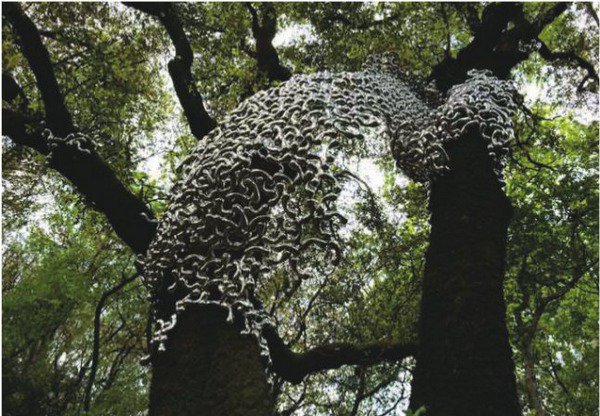Les Nouvelles Folies Francaises
dal 24/6/2013 al 13/10/2013
Segnalato da
Lee Bae
Pascal Bernier
Marc Boulet
Lin Yu
Celeste Boursier-Mougenot
Loris Cecchini
Herve Di Rosa
Pascal Dombis
Gil Percal
Joel Ducorroy
Jan Fabre
Jean-Pierre Formica
Dario Ghibaudo
Rainer Gross
Fabrice Langlade
Wesley Meuris
Come Mosta-Heirt
Vincent Olinet
Samuel Rousseau
Yu Sung Il
Pascale-Marthine Tayou
Valentin Van der Meulen
Jan Van Oost
Bob Verschueren
Joachim Van Den Hurk
Moo Chew Wong
Patrick Amine
24/6/2013
Les Nouvelles Folies Francaises
Musee d'Archeologie nationale et Domaine national, Saint-Germain-en-Laye
This exhibition in motion will be built as a multifaceted and infinite garden theatre. Are invited a selection of international artists who will create specially designed works to inhabit the gardens. They will implement ephemeral living sculptures for the paths and the large Terrace and some indoor areas.

Lee Bae, Pascal Bernier, Marc Boulet & Lin Yu, Céleste Boursier-Mougenot, Loris Cecchini, Hervé Di Rosa, Pascal Dombis & Gil Percal, Joël Ducorroy, Jan Fabre, Jean-Pierre Formica, Dario Ghibaudo,
Rainer Gross, Fabrice Langlade, Jérémie Lippmann, Wesley Meuris, Côme Mosta-Heirt, Vincent Olinet, Samuel Rousseau, Yu Sung Il, Pascale-Marthine Tayou, Valentin Van der Meulen, Jan Van Oost, Bob Verschueren, Joachim Van Den Hurk, Moo Chew Wong
curated by Patrick Amine
"Gardens, throughout the world,
mean both enclosure and paradise."
Gilles Clément
In the context of André Le Nôtre year (Paris,
12 March 1613 – 15 September 1700, Paris ‐
400th anniversary), we wanted to pay tribute to
the great French gardener who gave credibility to
the French style of formal gardens and a new way
of designing them. Le Nôtre acquired his reputation through his great and many designs including
Vaux-le-Vicomte, Chantilly and Versailles (Gardener
to king, Louis xiv from 1645 to 1670) ; worthy of
particular note, he designed Saint-Germain-en-Laye
gardens with their Large Terrace and offset perspective, Wattignies chateau (near Lille, his first garden),
then Marly-le-Roy, the Tuileries... as well as Italian
gardens in the Turin countryside, the Venaria Reale
(the Savoy family estate), the gardens of the Palazzo
Reale in the centre of Turin, and gardens in Germany
and England. André Le Nôtre also worked alongside Louis Le Vau and Charles Le Brun: he was no
stranger to the architecture and painting of his time.
He was also a collector.
Many words were penned about the spirit of the
French garden at the end of the 17th century, and
then again in the 18th, when reactions were more
animated. The freer and more « anarchic » English
landscaped garden was contrasted with designs like
Le Nôtre’s which were more « policed », « mathematical », geometric and rigorous, evoking the thinking
of Descartes. Over the centuries, Europe came to
envy them. We had great Italian style gardens with
their baroque flowerbeds and fountains, and romantic gardens, etc. Then there were the famous, purely
ornamental Follies, which appeared in gardens in the
18th century. These were varied architectural constructions inspired by Antiquity : the Temple of philosophy
(Jean-Jacques Rousseau’s garden), Greek colonnades,
Mongol tents and pagodas, Chinese doors, pyramids,
caves, and more particularly in the Désert de Retz
(near Chambourcy), or in Belgium, in Beloeil (near Brussels), gardens and follies conceived and designed
by the writer and soldier Prince de Ligne.
We refer to this historic filiation, and to the spirit
of Nature : « tamed » and modelled by the designers
of these historic gardens throughout time. For this
tribute to André Le Nôtre, we decided to bring this
history through the centuries back to life through his
designs and via the perspective offered by the large
chateaus and their gardens in their architecture, their
layout and their space.
We asked a selection of international artists to
think about and create « new contemporary Follies »
specially designed to inhabit the gardens. It is a matter,
for these artists, of examining their relationship with
Nature and the Landscape, and in a certain manner,
of reviving the lost subject of the painting and dialoguing with the arts in general. The artists will be
able to create ephemeral works according to the place
(or longer lasting ones depending on the title of the
event and its institutional reception), « in natura » living sculptures to inhabit the park, empty bases, paths
and the large Terrace ; their work will also be represented in the landscaped garden... A whole sequence in
St-Germain-en-Laye gardens and some indoor areas,
around the chateau and the chapel as well, etc.
This exhibition in motion will be built as a multifaceted and infinite garden theatre.
The public will be able to rub shoulders with the
strangest and most original of imaginations, with their
« dreams » in motion, with a constellation of images...
It may in particular comprise the composition of a
Chinese garden of a thousand surprises: Le Nôtre’s Chinese garden. Special plants will be on view, medicinal
plants, flowers, little-known Asiatic vegetables, and a
few surprises based around a paddy field... At night,
the works in the garden will be lit especially for this
exhibition.
We would like to build a fun area conducive to
walking and freedom of the imagination aroused by
the works created in this historical site.
Gardens have always been the subject of the philosophical and political expression of a time, and the
signature of a certain way of life. Isn’t it true that the
love of gardens is a real passion of the soul?
Patrick Amine
Image: Loris Cecchini
Press contact:
Ali Kedjam +33 1 39101324 +33 6 71292065 ali.kedjam@culture.gouv.fr
Service du développement culturel:
Virginie Gréboval +33 1 39101341 virginie.greboval@culture.gouv.fr
Opening 25 June 2013
Musée d’Archéologie nationale–Domaine national de Saint-Germain-en-Laye
Place Charles de Gaulle 78 105 Saint-Germain-en-Laye Cedex France
Le musée est ouvert de 10 h à 17 h, tous les jours sauf le mardi.
Le domaine est ouvert tous les jours de 8 h à 18 h
Plein tarif 6 € - Tarif réduit 4,50 €



